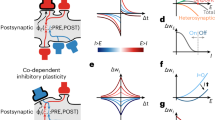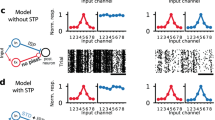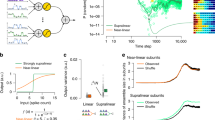Abstract
Triple whole-cell recordings from simple networks of cultured hippocampal neurons show that induction of long-term depression at glutamatergic synapses is accompanied by a back propagation of depression to input synapses on the dendrite of the presynaptic neuron. The depression also propagates laterally to divergent outputs of the presynaptic neuron and to convergent inputs on the postsynaptic neuron. There is no forward propagation of depression to the output of the postsynaptic neuron and no presynaptic propagation accompanying long-term depression at GABAergic synapses. Activity-induced synaptic modification is therefore not restricted to the activated synapse, but selectively propagates throughout the neural network.
This is a preview of subscription content, access via your institution
Access options
Subscribe to this journal
Receive 51 print issues and online access
$199.00 per year
only $3.90 per issue
Buy this article
- Purchase on Springer Link
- Instant access to full article PDF
Prices may be subject to local taxes which are calculated during checkout







Similar content being viewed by others
References
Purves, D. & Lichtman, J. W. Principles of Neural Development (Sinauer Associates, Sunderland, MA, (1985)).
Goodman, C. & Shatz, C. J. Developmental mechanisms that generate precise patterns of neuronal connectivity. Cell/Neuron 72/10, 77–98 (1993).
Katz, L. C. & Shatz, C. J. Synaptic activity and the construction of cortical circuits. Science 274, 1133–1138 (1996).
Bliss, T. V. & Lømo, T. Long-lasting potentiation of synaptic transmission in the dentate area of the anaesthetized rabbit following stimulation of the perforant path. J. Physiol. (Lond.) 232, 331–356 (1973).
Ito, M. The cellular basis of cerebellar plasticity. Curr. Opin. Neurobiol. 1, 616–620 (1991).
Bliss, T. V. & Collingridge, G. L. Asynaptic model of memory: long-term potentiation in the hippocampus. Nature 361, 31–39 (1993).
Linden, D. J. & Connor, J. A. Long-term synaptic depression. Annu. Rev. Neurosci. 18, 319–357 (1995).
Bonhoeffer, T., Staiger, V. & Aertsen, A. Synaptic plasticity in rat hippocampal slice cultures: local “Hebbian” conjugation of pre- and postsynaptic stimulation leads to distributed synaptic enhancement. Proc. Natl Acad. Sci. USA 86, 8113–8117 (1989).
Schuman, E. M. & Madison, D. V. Locally distributed synaptic potentiation in the hippocampus. Science 263, 532–536 (1994).
Kossel, A., Bonhoeffer, T. & Bolz, J. Non-Hebbian synapses in rat visual cortex. Neuroreport 1, 115–118 (1990).
Engert, F. & Bonhoeffer, T. Synapse specificity of long-term potentiation breaks down at short distances. Nature 388, 279–284 (1997).
Scanziani, M., Malenka, R. C. & Nicoll, R. A. Role of intercellular interactions in heterosynaptic long-term depression. Nature 380, 446–450 (1996).
McMahon, L. L. & Kauer, J. A. Hippocampal interneurons express a novel form of synaptic plasticity. Neuron 18, 266, 737–739 (1977).
Lynch, G. S., Dunwiddle, T. & Gribkoff, V. Heterosynaptic depression: a postsynaptic correlate of long-term potentiation. Nature 266, 737–739 (1977).
Abraham, W. C. & Goddard, G. V. Asymmetric relationships between homosynaptic long-term potentiation and heterosynaptic long-term depression. Nature 305, 717–719 (1983).
Christie, B. R. & Abraham, W. C. NMDA-dependent heterosynaptic long-term depression in the dentate gyrus of anaesthetized rats. Synapse 10, 1–6 (1992).
Otani, S., Connor, J. A. & Levy, W. B. Long-term potentiation and evidence for novel synaptic association in CA1 stratum-oriens of rat hippocampus. Learn. Mem. 2, 101–106 (1995).
Muller, D., Hefft, S. & Figurov, A. Heterosynaptic interactions between LTP and LTD in ca1 hippocampal slices. Neuron 14, 599–605 (1995).
Lo, Y. & Poo, M. -m. Activity-dependent synaptic competition in vitro: Heterosynaptic suppression of developing synapses. Science 254, 1019–1022 (1991).
Cash, S., Zucker, R. S. & Poo, M. -m. Spread of synaptic depression by presynaptic cytosolic signaling. Science 272, 998–1001 (1996).
Vincent, P. & Marty, A. Neighboring cerebellar Purkinje cells communicate via retrograde inhibition of common presynaptic interneurons. Neuron 11, 885–893 (1993).
Rumelhard, D. E., Hinton, G. E. & Williams, R. J. Parallel Distributed Processing: Explorations in the Microstructure of Cognition Vol. 1(eds Rumelhart, D. E. & McClelland, J. L.) 316–362 (MIT Press, Cambridge, MA, (1986)).
Churchland, P. S. & Sejnowski, T. J. The Computational Brain (MIT Press, Cambridge, MA, (1992)).
Wilcox, K. S., Buchhalter, J. & Dichter, M. A. Properties of inhibitory and excitatory synapses between hippocampal neurons in very low density cultures. Synapse 18, 128–151 (1994).
Bekkers, J. M. & Stevens, C. F. Excitatory and inhibitory autaptic currents in isolated hippocampal neurons maintained in cell culture. Proc. Natl Acad. Sci. USA 88, 7834–7838 (1991).
Goda, Y. & Stevens, C. F. Long-term depression properties in a simple system. Neuron 16, 103–111 (1996).
Tong, G., Malenka, R. C. & Nicoll, R. A. Long-term potentiation in cultures of single hippocampal granule cells: a presynaptic form of plasticity. Neuron 16, 1147–1157 (1996).
Dudek, S. M. & Bear, M. F. Homosynaptic long-term depresison in area CA1 of hippocampus and effects of N-methyl-D-aspartate receptor blockade. Proc. Natl Acad. Sci. USA 89, 4363–4367 (1992).
Mulkey, R. M. & Malenka, R. C. Mechanisms underlying induction of homosynaptic long-term depression in area CA1 of the hippocampus. Neuron 9, 967–975 (1992).
Bolshakov, V. Y. & Siegelbaum, S. A. Postsynaptic induction and presynaptic expression of hippocampal long-term depression. Science 264, 1148–1751 (1994).
Stevens, C. F. & Wang, Y. Changes in reliabiity of synaptic function as a mechanism for plasticity. Nature 371, 704–707 (1994).
Xiao, M. -Y., Wigstrom, H. & Gustafsson, B. Long-term depression in the hippocampal CA1 region is associated with equal changes in AMPA and NMDA receptor-mediated synaptic potentials. Eur. J. Neurosci. 6, 1055–1057 (1994).
Dan, Y. & Poo, M. -m. Hebbian depression of isolated neuromuscular synapses in vitro. Science 256, 1570–1573 (1992).
Cash, S., Dan, Y., Poo, M. -m. & Zucker, R. Depression of developing neuromuscular synapses by postsynaptic elevation of calcium. Neuron 16, 745–754 (1996).
Brocher, S., Artola, A. & Singer, W. Intracellular injection of Ca2+ chelators blocks induction of long-term depression in rat visual cortex. Proc. Natl Acad. Sci. USA 89, 123–127 (1992).
Murthy, V. N., Sejnowski, T. J., Stevens, C. F. Heterogenous release properties of visualized individual hippocampal synapses. Neuron 18, 599–612 (1997).
Clarke, P. G. H. The role of trophic communication in biological networks. Concepts Neurosci. 2, 201–219 (1991).
Jessell, T. M. & Kandel, E. R. Synaptic transmission: a bidirectional and self-modifiable form of cell-cell communicaiton. Cell/Neuron 72/10, 1–30 (1993).
Dan, Y. & Poo, M. -m. Retrograde interactions during formation and elimination of neuromuscular synapses. Curr. Opin. Neurobiol. 4, 95–100 (1994).
Davis, G. W. & Murphey, R. K. Retrograde signaling and the development of transmitter release properties in the invertebrate nervous system. J. Neurobiol. 25, 740–756 (1994).
Fitzsimonds, R. M. & Poo, M. -m. Retrograde signaling in the development and modulation of synapses. Physiol. Rev.(in the press).
Mathews, M. R. & Nelson, V. H. Detachment of structurally intact nerve endings from chromatolytic neurons of rat superior cervical ganglion during the depression of synaptic transmission induced by post-ganglionic axotomy. J. Physiol. (Lond.) 245, 91–135 (1975).
Purves, D. Functional and structural changes in mammalian sympathetic neurones following interruption of their axons. J. Physiol. (Lond.) 252, 429–463 (1975).
Wood, M. R. & Faber, D. S. Electrohysiological and morphological correlates of axotomy-induced deafferentation of the goldfish Mauthner cell. J. Comp. Neurol. 244, 413–426 (1986).
Pilar, G. & Landmesser, L. Axotomy mimicked by localized colchicine application. Science 177, 1116–1118 (1972).
Rumelhart, D. E., Hinton, G. E. & Williams, R. J. Learning representations by back-propagation errors. Nature 323, 533–536 (1986).
Zipser, D. & Rumelhart, D. E. in Computational Neuroscience (ed. Schwartz, E. L.) 192–200 (MIT Press, Cambridge, MA, (1990)).
Hamill, O. P., Marty, A., Neher, E., Sakmann, B. & Sigworth, F. J. Improved patch-clamp techniques for high-resolution current recording from cells and cell-free membrane patches. Pflügers Arch. 391, 85–100 (1981).
Horn, R. & Marty, A. Muscarinic activation of ionic currents measured by a new whole-cell recording method. J. Gen. Physiol. 92, 145–159 (1988).
Rae, J., Cooper, K., Gates, P. & Watsky, M. Low access resistance perforated patch recordings using amphotericin B. J. Neurosci. Meth. 37, 15–26 (1991).
Acknowledgements
We thank T. Mau for preparing cell cultures, and Y. Dan, B. Berninger and A.Schinder for discussion. This work was supported by grants from the NIH and the NSF.
Author information
Authors and Affiliations
Corresponding author
Rights and permissions
About this article
Cite this article
Fitzsimonds, R., Song, Hj. & Poo, Mm. Propagation of activity-dependent synaptic depression in simple neural networks. Nature 388, 439–448 (1997). https://doi.org/10.1038/41267
Received:
Accepted:
Issue Date:
DOI: https://doi.org/10.1038/41267
This article is cited by
-
Extracellular detection of neuronal coupling
Scientific Reports (2021)
-
Synaptic plasticity-dependent competition rule influences memory formation
Nature Communications (2021)
-
A nanoelectrode array for obtaining intracellular recordings from thousands of connected neurons
Nature Biomedical Engineering (2019)
-
Functional kinds: a skeptical look
Synthese (2015)
-
All-optical electrophysiology in mammalian neurons using engineered microbial rhodopsins
Nature Methods (2014)
Comments
By submitting a comment you agree to abide by our Terms and Community Guidelines. If you find something abusive or that does not comply with our terms or guidelines please flag it as inappropriate.



